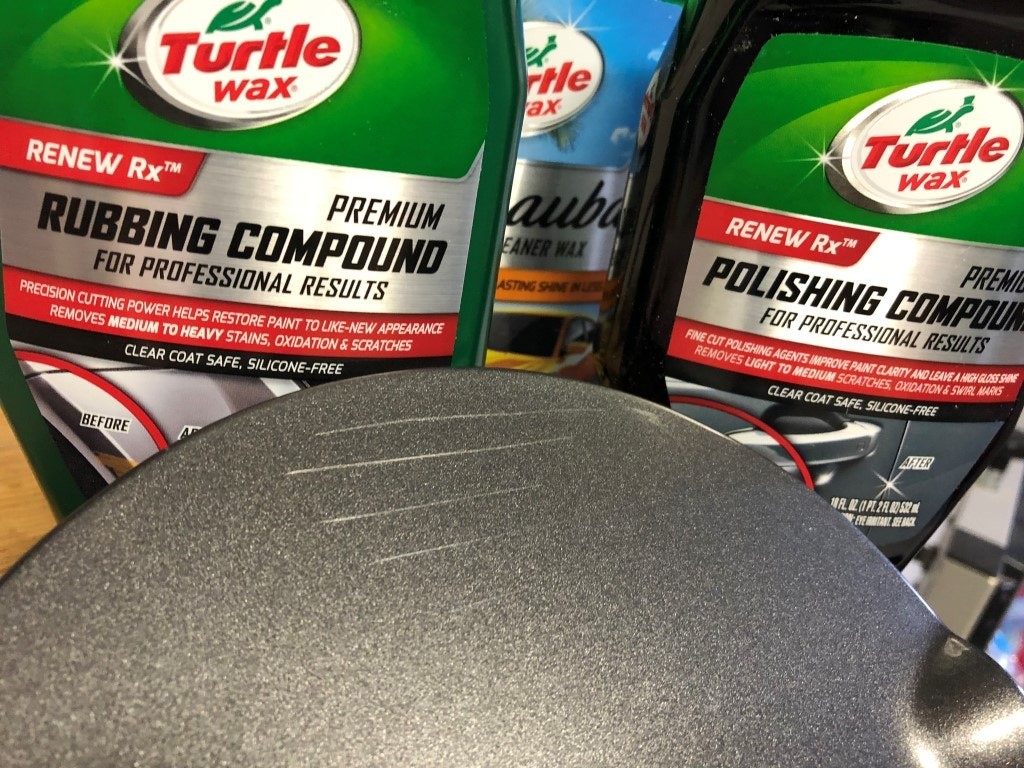Small scratches on your car are an inevitable annoyance. Whether it’s from stray branches, car doors in parking lots, or just everyday wear and tear, these minor blemishes can detract from your vehicle’s appearance. The good news is, you don’t always need to rush to a professional detailer for these superficial scratches. Learning how to buff out small scratches on your car is a valuable DIY skill that can save you time and money while keeping your car looking its best.
This guide will walk you through the process of identifying and removing minor car scratches, using techniques and products that are effective and safe for your car’s paint. We’ll explore practical methods, drawing insights from expert testing, to help you achieve professional-looking results right in your own garage.
Understanding Car Scratches: Is it Just a Surface Mark?
Before you grab your buffing tools, it’s crucial to understand the type of scratch you’re dealing with. Car paint typically consists of several layers:
- Clear Coat: This is the outermost layer, providing shine and protection. Most minor scratches only affect this layer.
- Base Coat (Color Coat): This layer provides the actual color of your car.
- Primer: This layer helps the base coat adhere to the metal body.
- Metal Body: The actual structure of your car.
For buffing out small scratches on your car, we’re primarily concerned with damage to the clear coat. If the scratch is shallow enough to only affect the clear coat, it’s often something you can fix yourself with the right techniques and products.
How can you tell if a scratch is minor enough for DIY buffing? A simple test is to run your fingernail lightly across the scratch. If your fingernail doesn’t catch in the scratch, it’s likely a clear coat scratch that can be buffed out. If your fingernail catches, or if you can see the scratch even when the area is wet, it might be deeper and require more aggressive methods, or even professional attention.
DIY Buffing for Minor Car Scratches: Step-by-Step
For those light, surface-level scratches, buffing is an effective solution. Here’s a step-by-step guide on how to buff out small scratches on your car at home:
1. Gather Your Supplies
To effectively buff out scratches, you’ll need the right tools and products. Here’s a list of essentials:
- Car Wash Soap and Water: To clean the area and remove any dirt or debris.
- Microfiber Wash Mitt and Drying Towels: Microfiber is gentle on your car’s paint and prevents further scratching.
- Rubbing Compound or Scratch Remover: This is an abrasive paste designed to level out the clear coat and remove scratches. For minor scratches, a fine-cut rubbing compound or a dedicated scratch remover is ideal.
- Polishing Compound: Used after rubbing compound to refine the finish and restore shine.
- Microfiber Applicator Pads: For applying the compounds.
- Microfiber Buffing Cloths: Clean, soft microfiber cloths for buffing and wiping away residue.
- Water Spray Bottle (Optional): For wet sanding (for slightly deeper clear coat scratches, proceed with caution).
- Detailing Clay Bar (Optional): To remove embedded contaminants before buffing.
2. Clean the Area Thoroughly
Before you start buffing, it’s crucial to clean the scratched area and the surrounding paint. Wash your car using car wash soap and water, paying extra attention to the area with the scratch. Rinse thoroughly and dry completely with a microfiber drying towel. This step removes dirt and grime that could further scratch the paint during the buffing process.
3. Apply Rubbing Compound or Scratch Remover
Apply a small amount of rubbing compound or scratch remover to a microfiber applicator pad. Using circular motions and moderate pressure, work the compound into the scratched area. Focus on working in small sections at a time. Avoid pressing too hard, especially initially. Let the abrasives in the compound do the work.
If you are dealing with slightly more noticeable clear coat scratches, you might consider very light wet sanding before using the rubbing compound. This involves using very fine grit sandpaper (2000-3000 grit) with water to gently level the clear coat. Caution: Wet sanding is more aggressive and should be done carefully to avoid damaging the paint. For most minor scratches, rubbing compound alone is sufficient.
4. Buff Out the Compound
After applying the rubbing compound, use a clean microfiber buffing cloth to buff away the residue. Use circular motions and light to moderate pressure. You should start to see the scratch diminishing or disappearing. If the scratch is still visible, you can repeat steps 3 and 4, applying more compound and buffing again. However, avoid excessive buffing in one area, as this can remove too much clear coat.
5. Polish the Area
Once you’ve removed the scratch with rubbing compound, it’s time to polish the area. Polishing compound is less abrasive than rubbing compound and is used to refine the finish, remove any swirl marks left by the rubbing compound, and restore the shine. Apply a small amount of polishing compound to a clean microfiber applicator pad and work it into the buffed area using circular motions.
6. Final Buff and Clean
After polishing, use a clean microfiber buffing cloth to buff away the polishing compound residue. Buff until you achieve a high-gloss shine. Inspect the area under different lighting conditions to ensure the scratch is no longer visible and the finish is even.
7. Wax or Seal for Protection
To protect your newly buffed area and enhance the shine, apply a coat of car wax or paint sealant. This will help protect the clear coat and maintain the results of your scratch removal efforts.
Machine Buffing: When You Need Extra Power
For larger areas of light scratches, or if you want to achieve even more consistent results, you can consider using a machine polisher. Machine polishers, like the Meguiar’s DA Power System tested in expert reviews, can significantly enhance the effectiveness of rubbing and polishing compounds.
These systems often attach to a standard drill and provide an orbital motion, which is safer and more effective than purely rotary polishers for DIYers. Using a machine polisher can save you time and effort, especially when dealing with larger or more stubborn minor scratches. They also tend to produce a more even and professional-looking finish.
Product Recommendations and Expert Insights
Based on product testing and expert opinions, several products stand out for effectively buffing out small scratches on your car:
- Meguiar’s Ultimate Compound: A popular and effective rubbing compound that works well for removing light to moderate scratches. Expert tests have shown it provides noticeably better results than some basic scratch removers, especially when paired with machine application.
- 3M Trizact Precision Scratch Kit: This kit is specifically designed for scratch removal and includes sandpaper for wet sanding, rubbing compound, and polishing compound. It’s noted for its effectiveness in improving even moderate scratches, although it requires more steps and caution due to the sanding component.
- Turtle Wax Scratch Repair Kit: For very light surface scratches, Turtle Wax offers more basic scratch removers. While less aggressive, they can be suitable for the most minor blemishes. However, for more noticeable scratches, stronger compounds like Meguiar’s or 3M are recommended.
Remember, as experts point out, no product can completely eliminate every scratch, especially deeper ones. The goal of buffing is to make scratches significantly less noticeable and restore the appearance of your car’s paint.
When to Seek Professional Help
While learning how to buff out small scratches on your car is a valuable skill, there are times when professional help is necessary. If you have deep scratches that penetrate beyond the clear coat into the base coat or primer, DIY buffing may not be sufficient. Attempting to aggressively buff out deep scratches can damage your paint further.
Signs you might need professional help include:
- Scratches that are deep enough to catch your fingernail.
- Scratches that are still visible after thorough cleaning and buffing with rubbing compound.
- Damage that extends to the color coat or primer.
- If you are uncomfortable with wet sanding or using machine polishers.
In these cases, a professional auto detailer or body shop can assess the damage and provide more advanced repair options, such as touch-up paint, wet sanding, or even repainting panels.
Conclusion: Keeping Your Car Scratch-Free
Knowing how to buff out small scratches on your car empowers you to maintain your vehicle’s appearance and address minor blemishes quickly and effectively. By understanding the types of scratches, using the right products and techniques, and knowing when to seek professional help, you can keep your car looking its best and protect its value. Regular washing, waxing, and prompt attention to scratches will go a long way in preserving your car’s finish for years to come.

